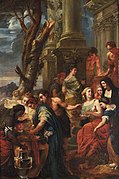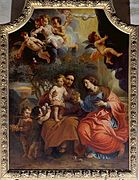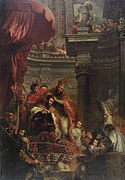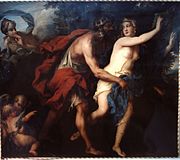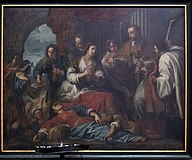Jan Erasmus Quellinus
Jan Erasmus Quellinus , also Jean-Erasme Quellinus , Jan Erasmus Quellin and Jan Erasmus Quellyn (baptized December 1, 1634 in Antwerp ; † March 11, 1715 in Mechelen ) was a Flemish history and portrait painter and member of the Antwerp artist family Quellinus .
Life
Quellinus was the son of Erasmus Quellinus II and his wife Catherina (nee de Hemelaer, † 1662). He was a student of his father and continued his style in his work: he adapted the classicistic style that his father had acquired in collaboration with his brother Artus Quellinus I since his return from Rome. He worked there for François Duquesnoy , who, as a very successful Flemish in Rome, represented a classicist, moderate baroque. Building on this training, Quellinus spent the years 1657–1659 in Rome, where he followed traditional rites and joined the Schildersbent, a group that was formed in Rome from northern European artists: he also took a tradition, a nickname - "Cederboom" - on.
He then stayed in Venice from around 1660 to 1661. There he made the acquaintance of Venetian baroque painting, whose peculiarities can be clearly distinguished from those of the Roman baroque. It is not unlikely that he was employed in the studio of Johann Carl Loth , because the born German was one of the most important contact points for Northern European artists in Venice. He also ran an extremely large workshop. These left countless works on which often only the students and employees worked: Carl Loth then only took a controlled look at them or corrected them with a few brushstrokes.
After his return, the Venetian influences in particular shaped the art of Jan Erasmus Quellinus: for example, the bearded men in the foreground, hunched over parallel to the picture surface, who very often and also emphatically enrich the composition. These can be found again and again with him: Jan Erasmus Quellinus takes up a characteristic of the Venetian school, which found a particularly dominant expression in the Qeuvre of Johann Carl Loth and his school. But also the classically inspired architectural settings of Paolo Veronese , clinging together with a richly colored coloring, rich costumes and the stage-like arranged scenery, which depicted the spatial depth in the picture more in static parallel layers than in dynamic diagonals, have become a predominant feature of his art. In 1662 he married Cornelia Teniers, a daughter of the painter David Teniers the Younger . On November 13, 1675, the couple's 8th child was baptized in Antwerp.
Immediately after his return to Antwerp he became a member of the Saint Luke guild there, and around 1674 he made a cycle for the refectory of the Abbey of Saint Michael, Antwerp, which is representative of the stylistic development of this artist. Quellinus is in Vienna around 1680 and works as court painter for Emperor Leopold I. In addition to other works, he created 15 ceiling paintings on the life of Charles V as their theme.
In 1712, Quellinus moved to Mechelen to live with one of his daughters and died there in 1715.
plant
The oeuvre of Jan Erasmus Quellinus is relatively untapped, his work is usually only mentioned in passing in the specialist literature. In addition, his painting is very similar to that of his father, so that it has always been difficult to distinguish the hands. For example, both worked together for the Augustinians in Antwerp from 1666 to 1668. One example is “The Holy Family” in Wörlitz Castle near Dessau, which before 1935 was listed as a work by Erasmus Quellinus II, but is now considered a work of his son. The similarity of names also leads to confusion or equations, this also in public collections.
An unsigned painting that came onto the art market in 2012 also documents this problem: Zeus, Semele and Hera was introduced in 2012 as a work by Erasmus Quellinus II, but for stylistic reasons could also be considered a work by his son Jan Erasmus Quellinus.
The cycle on Charles V, commissioned by Leopold I for the Vienna Hofburg around 1680 and one of the most representative and important commissions for Jan Erasmus Quellinus, also occupies an important position in the history of the Vienna Hofburg. With this cycle, reference should be made in a prominent place to the importance and the justified dynastic claims of the House of Habsburg. Due to the historical circumstances, the change in artistic taste and the conversion of the corresponding rooms, this cycle was dismantled and forgotten only a few decades after its creation. However, three paintings of the cycle are still preserved in the Kunsthistorisches Museum Wien and represent a central element of furnishing in the Vienna Hofburg in the last quarter of the 17th century: during the years of his reign, Emperor Leopold I brought their furnishing to an artistic level that matched the demands other important dynasties in Europe, especially those of the Bourbons under Louis XIV of France, should compete.
classification
Despite the stylistic development through the formative stay in Italy, Quellinus was very much committed to the work and aesthetics of his father: as an outstanding Rubens pupil in his time, he was recognized as a Pictor doctus , who, artistically and intellectually, was the current trend from Flemish painting to classicism. Jan Erasmus Quellinus, however, continued to use this traditional style and was unable to reposition himself in the changing art market: the colorful, but also somewhat heavy-blooded coloring and the sometimes statuesque, dry compositions in the middle of the classically inspired architecture countered the magnificently moving monumentality of the Gerard de Lairesse , also a Flemish, a little anachronistic. Even against the Arcadian visions of Antoine Watteau or the classically primed, but now elegant, playful and erotic connotations, French history painting by Nicolas Colombel, which was successful throughout Europe, could not really stand up to his art. And Venetian painting, which, like Quellinus, referred to the great model Paolo Veronese, was able to develop a lighter, more lively and contemporary aesthetic with Sebastiano Ricci or later, of course, Giambattista Tiepolo .
The fate of the Vienna cycle on Charles V can be seen as an example of the dwindling importance of the art of Jan Erasmus Quellinus. In Belgium's churches and museums, however, and also in museums across Europe, the oeuvre of Jan Erasmus Quellinus is still present. Although some of his works are of incomplete artistic quality due to the intensive cooperation of his apprentices and workshop employees, there are also many high-quality paintings by his hand.
literature
- Georg Kaspar Nagler : Quellinus, Johann Erasmus . In: New general artist Lexicon, or messages from the life and works of painters, sculptors, architects, engravers, die cutter, lithographer, illustrator, Medals and Ivory, etc . 3. Edition. tape 13 . Schwarzenberg & Schumann, Leipzig 1936, p. 382 ( books.google.de - first edition: 1843, unchanged reprint).
- Quellinus, Jan Erasmus . In: Hans Vollmer (Hrsg.): General lexicon of fine artists from antiquity to the present . Founded by Ulrich Thieme and Felix Becker . tape 27 : Piermaria – Ramsdell . EA Seemann, Leipzig 1933, p. 509-510 .
- Benezit - Dictionaire critique et documentaire des peintres, sculpteurs, dessinateurs et graveurs de tous les temps et de tous les pays par un groupe d'écrivains spécialistes français et étrangers. Volume 8, Emmanuel Bénézit, Paris 1976.
- Matias Díaz Padrón: Une Annonciation inédite de Jan Erasmus Quellinus in Madrid. In: Jaarboek - Koninklijk Museum voor Schone Kunsten. 1990.
- Jean-Pierre De Bruyn (ed.): Dans le sillage de Rubens: Erasmus II Quellinus (1607–1678). Exhibition catalog of the Musée de Flandre in Cassel, Ghent 2014.
- Günther Heinz: Studies on Jan van den Hoecke and the painting of the Dutch in Vienna. In: Yearbook of the Art History Collections in Vienna. NF 27 = 63.1967, pp. 109-164.
- Gustav Glück: The two Quellinus. In: Yearbook of the Art History Collections of the Very Highest Imperial House. Volume 24, 1903.
- Jan De Maere, Marie Wabbes: Illustrated dictionary of 17th century Flemish painters. Brussels 1994.
- Herbert Karner (ed.): The Vienna Hofburg 1521 - 1705, building history, function and establishment as an imperial residence. Vienna 2014.
Web links
Individual evidence
- ^ Alfred von Wurzbach : Quellinus, Jan Erasmus, called Sederboom (Ceder) . In: Dutch Artist Lexicon; edited on the basis of archival research . tape 2 : L-Z . Halm and Goldmann, Vienna / Leipzig 1910, p. 372–373 ( Text Archive - Internet Archive ).
- ^ Eduard Engerth: Quellinus, Jan Erasmus . In: Painting: Descriptive Directory . 2nd, revised edition. tape 2 : Dutch schools . Self-published, Vienna 1892, p. 358 ( Textarchiv - Internet Archive ).
- ^ Quellinus, Jan Erasmus . In: Hans Vollmer (Hrsg.): General lexicon of fine artists from antiquity to the present . Founded by Ulrich Thieme and Felix Becker . tape 27 : Piermaria – Ramsdell . EA Seemann, Leipzig 1933, p. 509-510 .
- ↑ a b Jean-Pierre De Bruyn (ed.): Dans le sillage de Rubens: Erasmus II Quellinus (1607–1678). Exhibition catalog of the Musée de Flandre in Cassel, Gent 2014, ISBN 978-94-6161-140-6 .
- ^ Dagmar Probst: The influence of the German Venetian Johann Carl Loth (1632–1698) on the baroque painters of the Cisalpine region. In: spaces and things. Bielefeld 2014.
- ^ Gerhard Ewald: Johann Carl Loth: 1632–1698. Amsterdam 1965.
- ^ Gerhard Ewald: Johann Carl Loth: 1632–1698. Amsterdam 1965, pp. 34-35.
- ↑ a b barokinvlaanderen ( Memento of the original from July 31, 2015 in the Internet Archive ) Info: The archive link was inserted automatically and has not yet been checked. Please check the original and archive link according to the instructions and then remove this notice.
- ^ Matias Díaz Padrón: Une Annonciation inédite de Jan Erasmus Quellinus à Madrid. In: Jaarboek - Koninklijk Museum voor Schone Kunsten. Antwerp 1990, p. 296.
- ^ Alfred von Wurzbach : Dutch Artist Lexicon; edited on the basis of archival research . tape 1 : A-K . Halm and Goldmann, Vienna / Leipzig 1906, p. 303 ( Textarchiv - Internet Archive - In the entry on Franciscus de Cock, who is named as the baptismal witness).
- ^ Günther Heinz: Studies on Jan van den Hoecke and the painting of the Dutch in Vienna. In: Yearbook of the Art History Collections in Vienna. NF 27 = 63.1967, p. 154 ff.
- ^ Benezit - Dictionaire critique et documentaire des peintres, sculpteurs, dessinateurs et graveurs de tous les temps et de tous les pays par un groupe d'écrivains spécialistes français et étrangers. Volume 8, Emmanuel Bénézit, Paris 1976.
- Jump up ↑ Lectures Relatives A L'Histoire Des Sciences, Des Arts, Des Lettres, Des Moeurs Et de La Politique En Belgique, Et Dans Les Pays Limitrophes. Volume 4, Felix Victor Goethals, Brussels 1838, p. 165.
- ↑ Jan De Maere, Marie Wabbes: Illustrated dictionary of 17th century Flemish painters. Brussels 1994.
- ↑ This documented in the photo archive Photo Marburg, photo no. 77,598, put online at bildindex.de .
- ↑ The Holy Family museum-digital.de.
- ↑ The Musée des Augustins in Toulouse presents two works under "Quellinus, Jan Erasmus", but cites the vita of Erasmus Quellinus II in the description with his attribution: The Martyrdom of St. Lawrence and St. Catherine on Mount Sinai , this one at augustins.org .
- ↑ On the basis of an expert opinion, it was offered as a work by "Erasmus Quellinus" (formulated imprecisely, meaning Erasmus Quellinus II): this at auction house Fischer, Lucerne, A 415, November 2012, lot 1013: fischerauktionen.ch ( Memento des Originals from April 2, 2015 in the Internet Archive ) Info: The archive link was automatically inserted and not yet checked. Please check the original and archive link according to the instructions and then remove this notice.
- ↑ Herbert Karner (Ed.): The Vienna Hofburg 1521 - 1705, building history, function and establishment as an imperial residence. Vienna 2014, in particular: The Leopoldine Wing. Pp. 377-421.
- ↑ The Leopoldine Wing - The Spanish Hall: Myth and Type. In: Herbert Karner (ed.): The Vienna Hofburg 1521 - 1705, building history, function and establishment as an imperial residence. Vienna 2014, pp. 411–416.
- ↑ Gustav Glück: The two Quellinus. In: Yearbook of the Art History Collections of the Very Highest Imperial House. Volume 24, 1903, pp. 42-47.
- ↑ Iconology of the Hofburg. In: Herbert Karner (ed.): The Vienna Hofburg 1521 - 1705, building history, function and establishment as an imperial residence. Vienna 2014, pp. 530-572.
| personal data | |
|---|---|
| SURNAME | Quellinus, Jan Erasmus |
| ALTERNATIVE NAMES | Quellinus, Jean-Erasme; Quellin, Jan Erasmus; Quellyn, Jan Erasmus; Quellinus, Johann Erasmus; Sederboom (pseudonym) |
| BRIEF DESCRIPTION | Flemish painter |
| DATE OF BIRTH | baptized December 1, 1634 |
| PLACE OF BIRTH | Antwerp |
| DATE OF DEATH | March 11, 1715 |
| Place of death | Mechelen |

